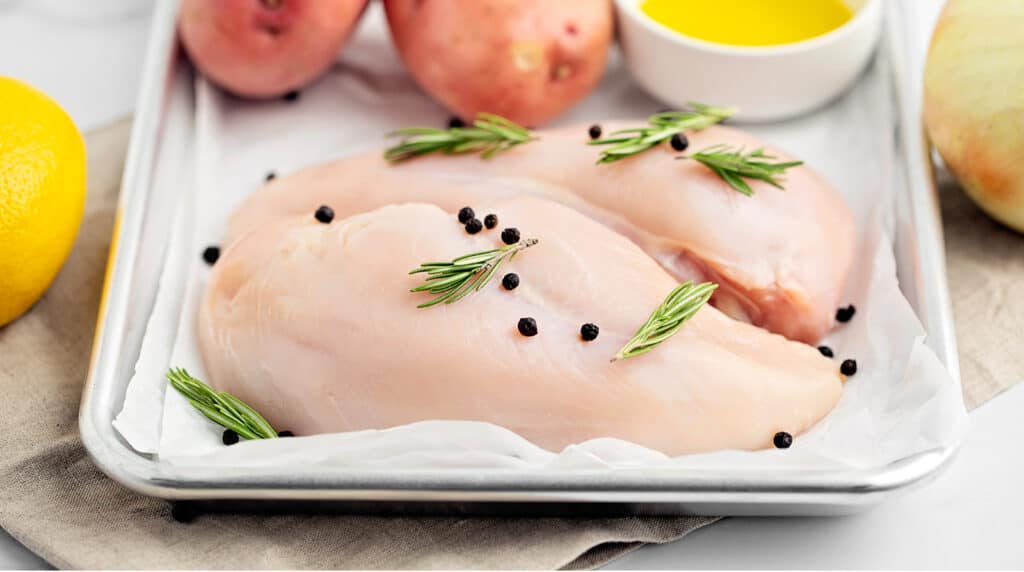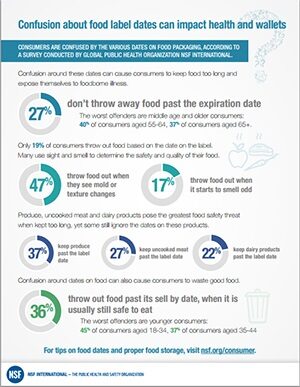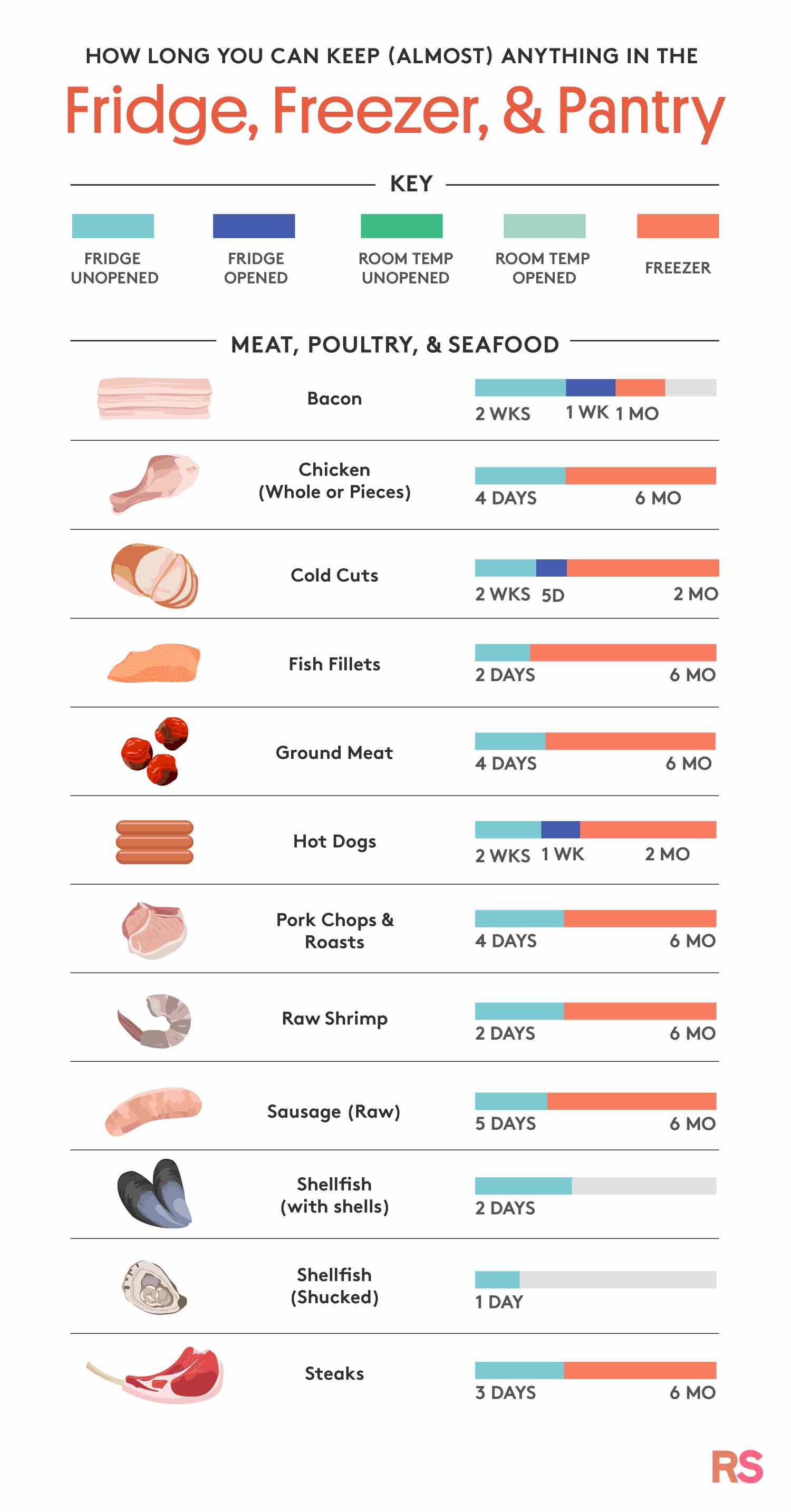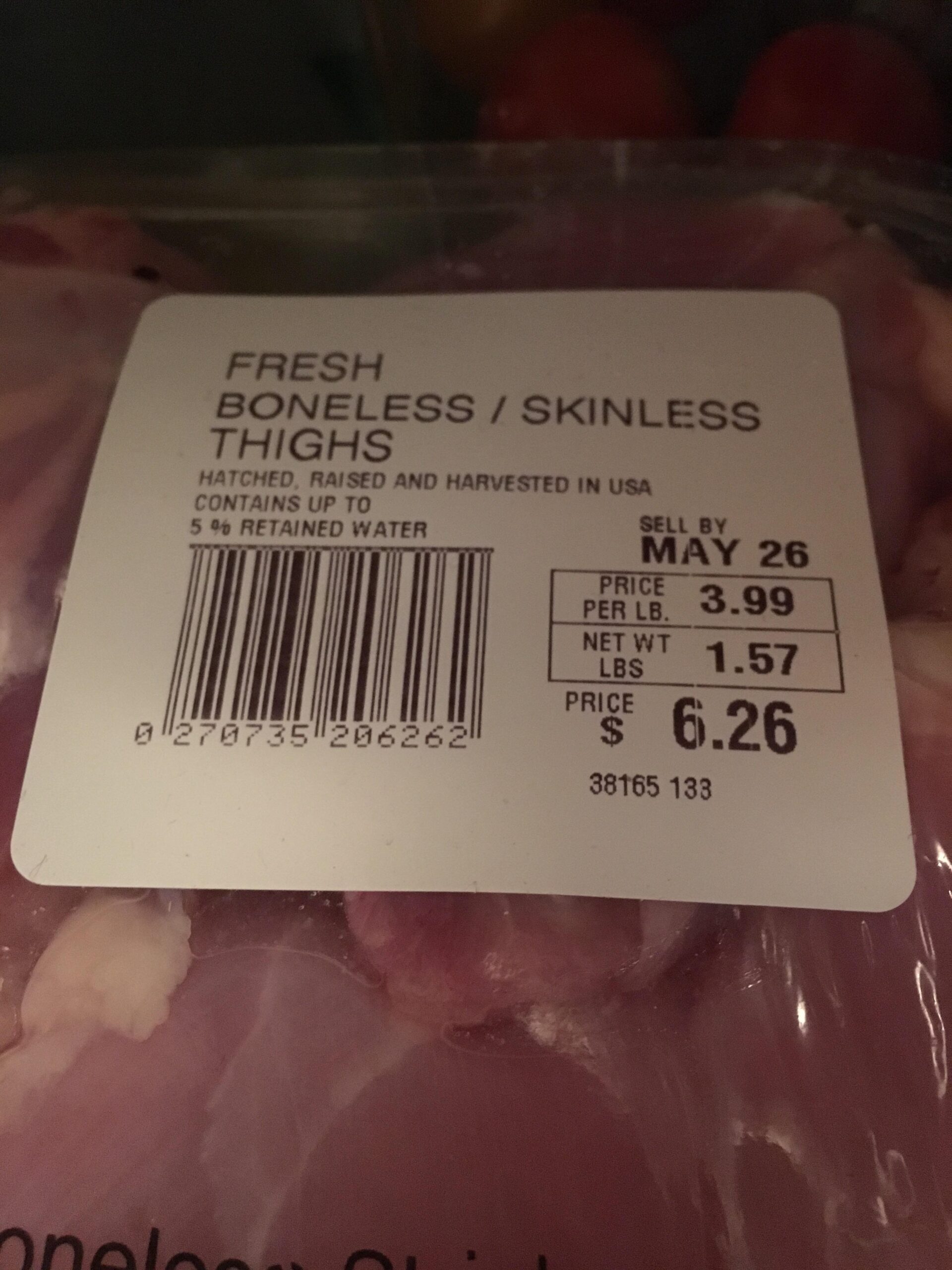
Chicken sell-by dates are manufacturer guidelines indicating the last day a store should sell the product for optimal freshness. These dates are not expiration dates—properly stored chicken can typically be safely consumed 1-3 days after the sell-by date.
| Storage Method | Raw Chicken | Cooked Chicken |
|---|---|---|
| Refrigerator (40°F or below) | 1-2 days past sell-by date | 3-4 days |
| Freezer (0°F or below) | 9-12 months | 2-6 months |
Key Takeaways:
- Sell-by dates are guidelines for stores, not expiration dates
- Properly stored chicken can be safe 1-3 days after the sell-by date
- Always check for signs of spoilage regardless of the date
- Freezing chicken extends its shelf life significantly
- Temperature control is crucial for chicken safety
Advantages of Following Sell-By Dates
- Better tasting, fresher chicken
- Reduced risk of foodborne illness
- Less food waste when properly planned
- Higher quality cooking results
Risks of Ignoring Sell-By Dates
- Potential exposure to harmful bacteria
- Deteriorated taste and texture
- Possible food poisoning symptoms
- Wasted money if chicken must be discarded
Getting to Know Chicken Sell-By Dates
What Are Sell-By Dates?
Sell-by dates are important labels on chicken packaging. They tell stores how long they should keep the chicken on the shelves for you to buy. Just remember this isn’t a strict expiration date. It’s more like a suggestion so you can grab the chicken while it’s still fresh.
Let’s say you spot a pack of chicken with a sell-by date of October 15. The store has to sell it by that date. But if you bring it home and store it right, you can probably eat it safely for a few days after that date too.
Why Sell-By Dates Matter
These dates aren’t just for show; they actually help ensure you’re getting fresh and safe chicken.
Here’s why knowing about sell-by dates is key:
- Quality Assurance: Buying chicken before that sell-by date means better taste and freshness.
- Safety Precautions: These dates help keep things safe because chicken that sits too long could grow harmful bacteria if not stored right.
- Consumer Responsibility: Understanding sell-by dates helps you decide when to cook or freeze your chicken.
Paying attention to these dates can help you enjoy your chicken while it’s good and cut down on waste. A quick look at the sell-by date might save you from tossing out perfectly good chicken!


Breaking Down Sell-By Dates
How to Read Sell-By Dates
Grasping sell-by dates is super important for keeping your food safe, especially with chicken. The sell-by date is mostly for stores so they know when to take the chicken off the shelves. Once it passes that date, they’re expected to remove it to keep quality up.
But don’t stress if you have chicken that’s past the sell-by date. If you keep it in the fridge at 40°F or less, you can often use it safely for a few days after the date.
For example, if you grab a chicken pack with a sell-by date of March 10, and get it home on March 9 and chill it right away, it’s likely fine to cook it until March 13 or 14, as long it looks and smells good.
Sell-By vs. Use-By vs. Best-By Dates
Now that you’re up to speed on sell-by dates, let’s clear up the difference between them and other common date labels like use-by and best-by.
- Use-By Date: This is the last date suggested by the manufacturer for the best flavor and quality. Try to eat it by this date for the best experience.
- Best-By Date: Similar to use-by, it shows when the product’s likely to be at its peak. Foods might still be safe after this date, but they won’t taste as good.
These labels can definitely be a bit confusing, but knowing what they mean helps you make smart choices. Next time you’re shopping for chicken, take a moment to check out those dates. It’ll help you enjoy fresher meals and stop wasting food!


What Affects Sell-By Dates
How Storage Affects Freshness
The conditions where chicken is stored really matter when it comes to sell-by dates. Storing it correctly can help keep it fresh and safe, while poor storage can speed up spoilage.
If you get home with chicken and just shove it in a messy fridge, you could be asking for trouble. Chicken should be kept at or below 40°F. Check out these storage tips:
- Refrigeration: Keep chicken cold! Raw chicken can usually last about 1-2 days in your fridge after you buy it. If the sell-by date is coming up, cook or freeze it fast.
- Freezing: If you freeze chicken on or before the sell-by date, it can last much longer. A whole chicken can stay safe for up to a year in the freezer, and cuts generally last around 9 months.
Being smart about how you store chicken helps it last longer, cuts down on food waste, and makes sure your meals are safe.
Effects of Packaging
The type of packaging also plays a big part in how long chicken stays fresh.
For example:
- Vacuum-Sealed Packaging: Chicken in vacuum-sealed packs has air taken out, which slows spoilage. It can often stay fresh longer than chicken packed in regular wrapping, pushing back the sell-by date a bit.
- Traditional Wrapping: On the flip side, chicken wrapped in butcher paper or foam does not last as long because it’s exposed to more air, leading to quicker spoilage. So you might need to eat or freeze it sooner.
When you’re shopping, take a moment to look at how the chicken is packaged. Choosing vacuum-sealed options when you can helps save time and money while keeping your meals safe and tasty longer. How things are packaged matters for keeping that chicken fresh until the sell-by date.


Staying Safe
How to Handle Chicken After the Sell-By Date
When it comes to chicken, safety is super important, especially about those sell-by dates. These dates give you a good idea of when stores should sell the chicken, but they don’t mean you can’t eat it at home right after that. Here are some steps to keep it safe after the sell-by date:
- Quick Inspection: Always check the chicken closely. If it smells fine and doesn’t look off, it’s probably still okay.
- Store it Right: If you bought chicken close to the sell-by date and aren’t using it right away, freeze it as soon as you can. Frozen chicken can last up to 12 months!
- Cooking Tips: If the chicken is past the sell-by date but still smells fresh, use it within a day or two. Just make sure to cook it well so it reaches 165°F inside.
- When in Doubt, Toss it Out: Trust your gut! If something feels off, it’s better to be safe than risk it. Bacteria that cause food poisoning can grow quickly on spoiled chicken.
Following these simple tips can really help you enjoy chicken safely and keep your meals tasty and healthy.
The Risks of Eating Expired Chicken
It might be tempting to use chicken that’s just past its sell-by date, but you need to be aware of the risks. Eating expired chicken can lead to health problems, mainly due to foodborne illness from nasty bacteria like Salmonella or Campylobacter.
Check out these risks of eating expired chicken:
- Foodborne Illness: The biggest risk is getting sick from bacteria that thrive in spoiled food, causing nausea, vomiting, diarrhea, and fever.
- Higher Risk of Contamination: If chicken is mishandled or not stored properly, it can carry a higher risk of spoilage bacteria growing.
- Serious Illness: Some folks, like kids, the elderly, or people with weak immune systems, might face more severe issues from foodborne illnesses, which could even lead to hospitalization.
So the best way to go is to prioritize safety by following these guidelines and being careful with chicken storage and handling. It’s all about sticking to those sell-by dates and making food choices that keep you feeling good!


How to Check if Chicken is Still Fresh
- Look at the colorFresh raw chicken should be pink, not gray or yellow. Cooked chicken should be white, not pink.
- Smell the chickenFresh chicken has little to no odor. If it smells sour, ammonia-like, or foul, discard it.
- Check the textureFresh chicken should feel moist but not slimy. If it feels sticky or tacky, it’s likely spoiled.
- Examine the packageCheck for excessive liquid in the package and bloating, which can indicate bacterial growth.
- Consider the storage conditionsIf chicken has been left at room temperature for over 2 hours or in temperatures above 40°F, discard it regardless of date or appearance.
Tips for Handling Sell-By Dates
Smart Storage Practices to Keep it Fresh
Figure out sell-by dates for chicken might seem tricky, but if you know proper storage tips, it gets a lot easier. We don’t want to waste good food, right? Here are some handy tips to keep your chicken fresh as long as possible:
- Watch the Temperature: Make sure your fridge is at 40°F or colder. This matters because warmer temps can speed up spoilage and mess with the sell-by date.
- Chill it Right Away: As soon as you get home from grocery shopping, pop your chicken in the fridge. Waiting too long can let bacteria grow.
- Freeze for a Longer Life: If you get chicken close to the sell-by date and can’t use it just yet, freeze it. Depending on the cut, chicken can stay safe in the freezer for months—up to a whole year for whole chickens!
- Go for Vacuum-Sealed Packs: If you find them, choose vacuum-sealed packages. They last longer than standard ones because they limit air exposure.
By following these simple strategies, you can give your chicken more life, making it great for last-minute meals or meal prepping.
How to Spot Spoiled Chicken
Even with great storage, it’s crucial to know when it’s time to toss chicken. Watch out for these signs that it might be bad:
- Bad Smell: Trust your nose! Fresh chicken has a mild scent. If it smells awful, it’s a sign to get rid of it.
- Odd Color: Chicken should be pink. If you see any greyish areas or dark spots, that’s a sign something’s off.
- Weird Texture: Fresh chicken feels moist but not slimy. If it’s sticky or slippery to the touch, it’s time to throw it out.
- Use-By Dates Passed: Even if chicken looks fine, if it’s past its use-by date, don’t risk it.
Keeping an eye out for these signs and sticking to the guidelines can help ensure your chicken is safe to eat and delicious. Just remember: when in doubt, it’s better to be cautious and throw it out!



Clearing Up Common Myths
Myth: Expired Chicken is Never Safe
A common myth about chicken is that if it’s past the sell-by or expiration dates, it’s automatically unsafe to eat. While it’s wise to play it safe, that’s not entirely true.
- Grace Period: Often, chicken is still fine for a day or two after the sell-by date if it’s been stored well. Fresh chicken lasts for about 1-2 days in the fridge after you buy it, and can stay safe in the freezer for months.
- Check for Spoilage: Always inspect the chicken before tossing it away. Look for smells, discoloration, or a slimy surface. If it seems fine, it might still be good to cook.
By knowing the facts, you can cut down on unnecessary food waste while staying safe in the kitchen.
Sell-By Dates and Food Safety
Sell-by dates can stir up confusion about food safety, especially with chicken. These dates are mostly for retailers to figure out how long to display their products. They don’t purely indicate safety for you at home.
- Quality vs. Safety: The date isn’t a safety date. Chicken can still be perfectly safe to eat after this date if kept properly. The Food Safety and Inspection Service suggests checking other freshness cues along with the sell-by date.
- Handling Properly: Keeping chicken at 40°F or lower can hugely extend how long it stays good. As long as you handle it right, it can still be safe to eat even if the sell-by date has come and gone.
Getting clear on sell-by dates helps you make better choices, cut down on food waste, and enjoy your meals more. So next time you check out chicken in your fridge, keep in mind these dates are just suggestions, not hard rules!
Frequently Asked Questions About Chicken Sell-By Dates
Can I eat chicken after the sell-by date?
Yes, you can typically eat chicken 1-3 days after the sell-by date if it has been properly refrigerated at 40°F or below. Always check for signs of spoilage such as off odors, sliminess, or discoloration before consuming. When in doubt, throw it out.
What’s the difference between sell-by, use-by, and best-by dates on chicken?
“Sell-by” dates tell stores how long to display the product. “Use-by” dates indicate when the chicken might begin to lose quality. “Best-by” dates suggest when to consume for optimal flavor. None are safety dates—proper storage and handling matter more than these dates for determining safety.
How can I tell if chicken has gone bad?
Spoiled chicken typically has a sour or ammonia-like smell, a slimy or sticky texture, and may show color changes to gray, green, or yellow. If you notice any of these signs, discard the chicken immediately regardless of the date on the package.
How long can I freeze chicken past its sell-by date?
Raw chicken can be frozen for 9-12 months, and cooked chicken for 2-6 months, regardless of the sell-by date. Freezing at 0°F or below stops bacterial growth, though quality may gradually decline. For best quality, freeze chicken before the sell-by date passes.
What temperature should chicken be cooked to for safety?
Chicken should always be cooked to an internal temperature of 165°F (74°C) as measured by a food thermometer in the thickest part of the meat. This temperature kills harmful bacteria like Salmonella and Campylobacter that may be present, making the chicken safe to eat regardless of its sell-by date.

A Bergen County institution celebrating authentic Jewish cuisine since 1985. Our pastrami—brined for 14 days, smoked over applewood for 12 hours, and steamed to perfection—creates a melt-in-your-mouth experience that rivals Manhattan’s finest delis. Our rye bread is baked fresh daily using a century-old recipe from Poland. Featured in Food & Wine’s “Top 10 Delicatessens in America” and on Food Network’s “Best Thing I Ever Ate.” Chef Moshe Greenbaum, a third-generation deli master trained at the Culinary Institute of America, ensures every sandwich meets our exacting standards. No wonder our customers drive from three states away.

Leave a Reply